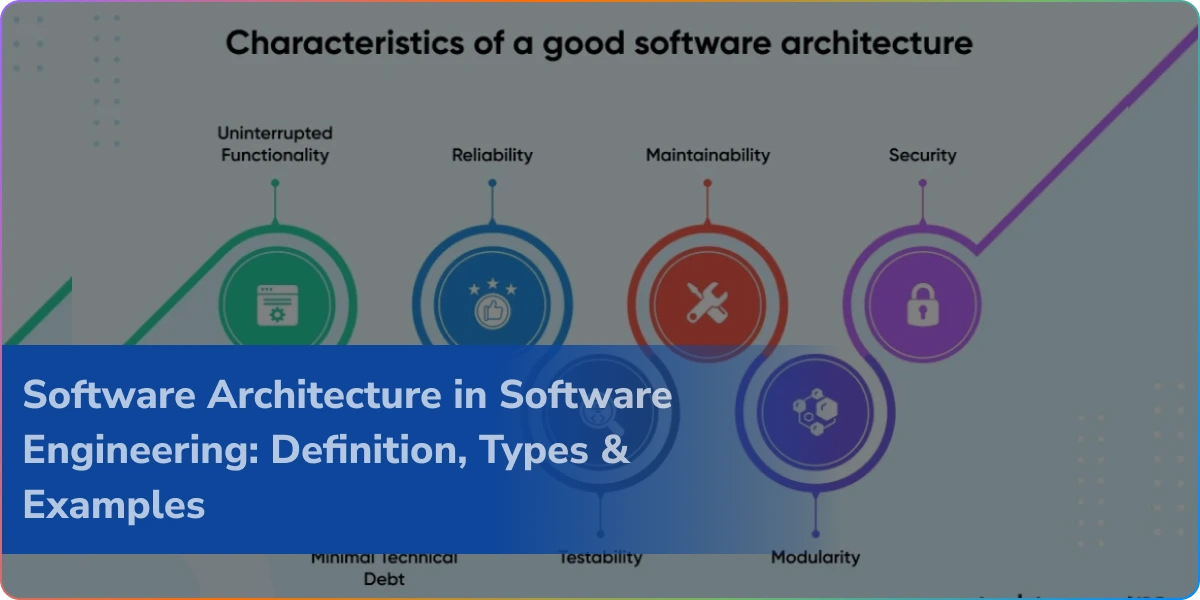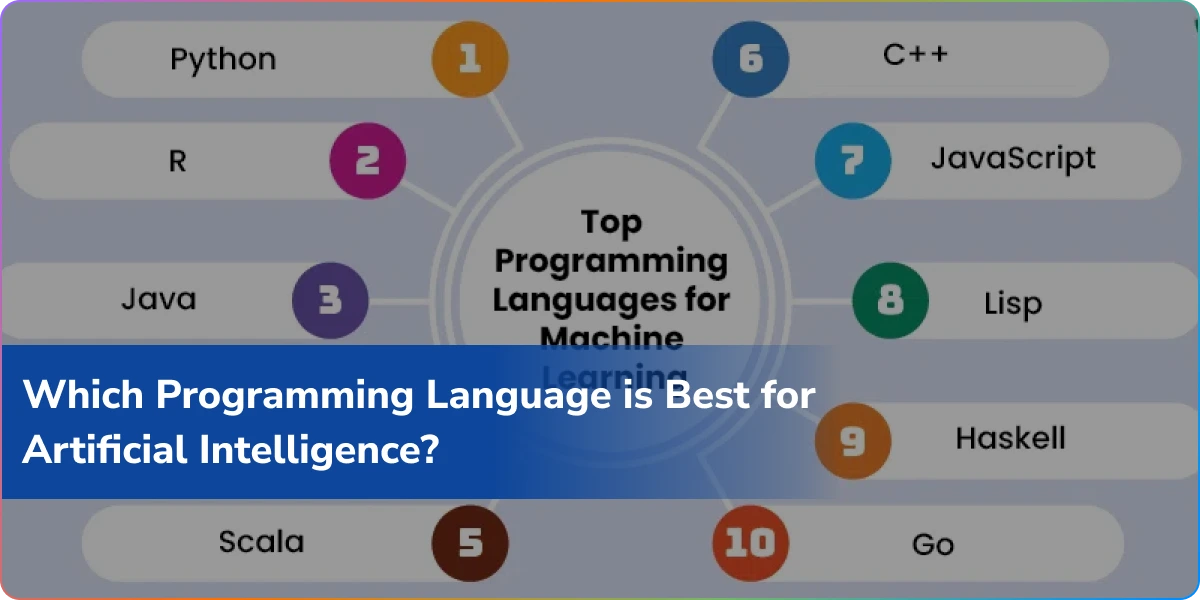Do you wonder what powers self-driving cars, medical AI tools, or financial forecasting systems? The secret lies in AI programming languages. Developers use these languages to process data, train models, and build intelligent applications.
In 2025, developers rely on a few top AI programming languages to create scalable and efficient solutions. In this blog, we’ll explore these languages, show their strengths, and help you pick the best language for AI for your project.
Why Do AI Development Languages Matter?
If we ask, “What programming language is used for AI?,” then there is no one correct answer. There are different programming language used for AI with different advantages—some are efficient for data analysis, some are great at deep learning, and some are perfect at performance-driven tasks.
The choice of an AI development language directly impacts your project’s success:
Development speed – High-level programming languages like Python enhance the velocity of a prototype, and C++ delivers maximum performance.
Library support – Python and R differentiate with very advanced machine learning and AI libraries.
Scalability – Business projects frequently depend upon Java and Julia for big-scale Artificial Intelligence solutions.
Community support – Popular AI languages offer vast resources, tutorials, and active communities for faster problem-solving.
1. Python – The King of AI Languages
Python dominates AI development with its simplicity, flexibility, and rich ecosystem. Developers use it to build chatbots, train deep learning models, and process massive datasets with ease.
Why Python leads AI development:
- Rich library collections such as Scikit-learn, PyTorch, and TensorFlow.
- Easy-to-understand syntax and readability.
- Strong worldwide community and resources.
- Suitable for machine learning, NLP, computer vision, and deep learning tasks.
Python is the first choice whenever someone inquires about the best languages for AI because of the excellent balance between usability and the best performance that it maintains.
2. R – The Statistical Powerhouse
If you’re diving into AI with a focus on numbers, research, and data-heavy projects, R should be on your list. Data scientists love it because it makes statistical modeling and visualization effortless.
Why R works so well for AI:
- Great at handling data analysis and stats.
- Comes with libraries like caret, randomForest, and nnet.
- Perfect for AI projects driven by research and statistics.
That’s why R remains a favorite in academia and among researchers.
3. Java – The Enterprise AI Language
When it comes to enterprise-level AI, Java still shines as one of the best languages for AI. Its platform independence and scalability make it perfect for building large, reliable systems that businesses can trust.
Strengths of Java for AI:
- Easily scales across platforms and big projects.
- A favorite in enterprise software, banking, and big data solutions.
- Packed with AI-ready libraries like Deeplearning4j and Weka.
So, if someone asks you what programming language is used for AI in enterprises, the answer is often Java.
4. C++ – Speed and Efficiency
When speed is everything, C++ stands out as one of the best languages for AI. Its efficiency and control over system resources make it the go-to choice for AI applications where milliseconds matter.
Why developers choose C++ for AI:
- Fast execution and effective memory management.
- Ideal for real-time AI systems in robotics, gaming, and simulations.
- Compatible with frameworks like Shark and mlpack.
That’s why many developers consider C++ the best option for performance-driven AI projects.
5. Julia – The Rising Star of AI Languages
Julia is quickly gaining recognition as one of the top AI programming languages, thanks to its perfect mix of speed and simplicity.
Benefits of Julia for AI:
- Delivers high performance that rivals C++.
- Specifically designed for numerical computing and data science.
- Offers powerful AI libraries like Flux.jl and MLJ.jl for machine learning and deep learning.
That’s why many developers now see Julia as the best answer to what programming language is used for AI in scientific and mathematical projects.
6. JavaScript – Bringing AI to the Web
JavaScript may not be the first language that comes to mind for AI, but it’s quickly becoming a game-changer for web-based AI applications.
Why JavaScript for AI?
- Blends well with other existing-web technologies.
- Popular libraries like TensorFlow.js and Brain.js let you build and run AI models right in the browser.
- Best for running AI applications directly in the client browser with low server-side dependencies.
If you are looking forward to embedding intelligent, interactive AI components into the web applications, JavaScript is among the top programming languages for AI in the world of the web.
7. LISP – The Original AI Language
LISP is a very old programming language for AI and is well-known for symbolic processing and versatility.
Why LISP remains relevant in AI:
- Suitable for rapid prototyping and educational research applications.
- Strong in symbolic reasoning and natural language processing tasks.
- A cornerstone in the history of AI innovation, influencing many modern AI languages.
While LISP is no longer a popular option, it is a landmark in the development of programming languages of Artificial Intelligence.
8. Prolog – Logic-Based AI
Prolog is a classical AI programming language widely recognized for creating rule-based and logic-driven systems.
Key features of Prolog:
- Ideal for AI applications in natural language processing and expert systems.
- Strong at logical reasoning and knowledge representation.
- Perfect for AI projects that rely on structured rules.
Today, Prolog is still valued in AI education, as it helps students clearly understand how logic forms the foundation of intelligent systems.
9. Scala – Functional Meets AI
Scala is becoming popular as an programming language for Artificial Intelligence because it unifies functional and object-oriented programming in one powerful tool.
Why programmers choose Scala for AI:
- Runs in the Java Virtual Machine (JVM), with excellent scalability ensured.
- It integrates well with larger data systems like Apache Spark.
- Provides support for machine learning libraries such as Breeze.
With the capability of handling both big data and AI workloads, the choice of Scala for developing in AI in big data applications is one of the best.
10. MATLAB – Engineering and AI Solutions
In engineering, robotics, and signal processing, the very robust programming language used in the case of AI is MATLAB.
Why do developers choose MATLAB for AI:
- It also has inherent mathematical simulation and modeling properties.
- You get ready-to-use toolboxes in deep learning, neural networks, and machine learning.
- With powerful visualization tools, it is very easy to analyze results and data.
While MATLAB is rarely the first choice of breadth-level AI projects, it is one of the leading programming languages of AI applications in engineering, research, and the sciences.
Choosing the Best AI Language for Your Project
So, which programming language is most commonly used for AI? It really depends on your project goals.
- If you’re building general AI or machine learning models, use Python.
- For statistics, analysis, and research work, R is the best choice.
- Need enterprise-scale AI applications? Java is a solid option.
- Working on performance-heavy systems? Choose C++ or Julia.
- For web-based AI solutions, JavaScript is a great fit.
- If your project requires logic-based AI systems, consider Prolog or LISP.
- Handling big data with AI? Scala works well.
- For engineering-focused AI applications, MATLAB is a standout.
Each of these AI development languages has its strengths. Choosing the right one can make a big difference in building smart, scalable solutions.
Each of these AI development languages has its own strengths—and choosing the right one can make all the difference in building smart, scalable solutions.
| AI Language | Strengths | Weaknesses | Best Use Case |
| Python | Easy, huge libraries | Slower than C++ | ML, Deep Learning |
| R | Statistical analysis | Less general-purpose | Data Science |
| C++ | High performance | Complex syntax | Robotics, real-time AI |
| Java | Scalable, enterprise | Verbose code | Enterprise AI, Big Data |
| Julia | Speed, math-heavy | Smaller community | Scientific AI |
Case Studies: Real-World Use of AI Languages
Tesla – Autonomous Vehicles
Tesla’s Autopilot employs C++ for real-time performance and Python for training AI models. This combination makes road decision-making both rapid and secure.
Google DeepMind – Machine Learning Research
DeepMind uses Python for machine learning tests and C++ for intensive computation, demonstrating that the most effective AI languages complement each other.
Netflix – Recommendations
Netflix leverages Python to drive its recommendation engine. Everything from data analysis to machine learning pipelines driving personalized content is managed by Python.
AI for various Industries
| Industry | Preferred AI Development Languages | Reason for Adoption |
| Healthcare AI | Python | Ideal for data-heavy models, medical imaging, ML libraries like TensorFlow & PyTorch |
| Finance & Trading AI | R, Python | Strong in data analytics, predictive modeling, and risk analysis |
| Autonomous Vehicles & Robotics | C++ | Needed for real-time performance, hardware-level control, and speed |
| Enterprise Applications | Java, Scala | Works well with Big Data, Apache Spark, and enterprise-scale systems |
| E-commerce & Retail | Python, JavaScript | For recommendation engines, personalization, and chatbots |
| Gaming & AR/VR | C++, C# | High-performance real-time rendering and AI-driven environments |
| Cybersecurity | Python, C | Used in threat detection, anomaly detection, and automation tools |
| Research & Academia | Python, R | Preferred for prototyping, statistical modeling, and academic ML experiments |
Conclusion
Artificial intelligence is the future of intelligent solutions, and each language—from Python to Java to Julia—has strengths of its own. All that is needed is to choose the right one that correlates with the purpose and innovation necessity.
Logixbuilt Solutions turns AI languages into tangible solutions. From applications to automation solutions, our experts get you to design smarter, faster, and future-enabled products. Let’s create your AI innovation today.
FAQ’s
Q1: Which is the best AI programming language in 2025?
Ans: Python dominates AI programming in 2025 due to ease of use, huge libraries (TensorFlow, PyTorch, Scikit-learn), and a vibrant community.
Q2: Why implement C++ for AI when Python is simpler?
Ans: C++ provides speed and efficiency and is perfect for real-time AI in robotics, gaming, and autonomous systems.
Q3: Is Java outdated for AI projects?
Ans: Yes. Java drives enterprise AI, big data solutions, and large-scale systems because of its security and scalability.
Q4: What language is best for AI research?
Ans: Python and R reign supreme in research projects thanks to their support for statistics, modeling, and prototyping at a rapid pace.
Q5: Is it possible for one AI project to use more than one language?
Ans: Absolutely. Projects commonly employ Python for ML models, C++/Java for speed, and JavaScript for deployment on the web.



